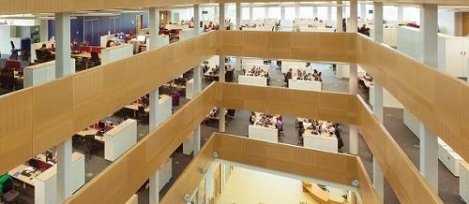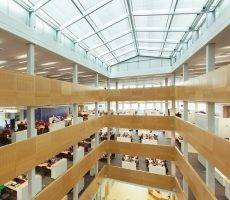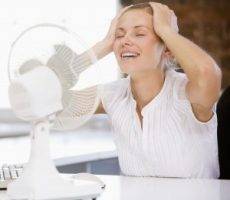September 1, 2016
BSRIA publishes new downloadable guide to indoor air quality 0
 The Building Services Research and Information Association (BSRIA) has released a new topic guide on indoor air quality (IAQ), which is now available to download free from the association’s website. The guide is written for those seeking some introductory information about indoor air quality including prevalence, history and definition, along with information on types of contaminants and their exposure limits, while readers are also provided with a useful site map. BSRIA’s asset performance team leader, Blanca Beato-Arribas, said: “People spend approximately 80 per cent of their time indoors. There is enough evidence that links poor air quality with permanent damages to health or even death. Therefore, we should be aware of the quality of the air that we breathe both at home and at work, and ensuring good indoor air quality at work should be a priority for employers.” The guide will provide insight into the most common contaminants, both from indoor sources and external sources as well as a summary of the current legislation and a guide map of what contaminants to investigate.
The Building Services Research and Information Association (BSRIA) has released a new topic guide on indoor air quality (IAQ), which is now available to download free from the association’s website. The guide is written for those seeking some introductory information about indoor air quality including prevalence, history and definition, along with information on types of contaminants and their exposure limits, while readers are also provided with a useful site map. BSRIA’s asset performance team leader, Blanca Beato-Arribas, said: “People spend approximately 80 per cent of their time indoors. There is enough evidence that links poor air quality with permanent damages to health or even death. Therefore, we should be aware of the quality of the air that we breathe both at home and at work, and ensuring good indoor air quality at work should be a priority for employers.” The guide will provide insight into the most common contaminants, both from indoor sources and external sources as well as a summary of the current legislation and a guide map of what contaminants to investigate.















 A ‘stiff upper lip’ attitude towards wellness by UK bosses needs to change in order to advance employee wellbeing, argues a survey by Bupa. It is business leaders who are the key to overcoming the challenges facing employees’ health and wellbeing, it claims. The vast majority (94 percent) of those questioned believe there will be significant change in the employer-employee relationship in the next ten years. 91 percent of business leaders agree that technology will continue to impact the wellbeing of their workforce over the next decade and 71 percent agree the standard 9am-5pm working day is a thing of the past. Seven in ten (68 percent) noted a ‘stiff upper lip attitude’ at executive level, creating barriers to conversations about wellbeing, and three fifths (62 percent) of leaders think they need to show that they don’t suffer from ill health.
A ‘stiff upper lip’ attitude towards wellness by UK bosses needs to change in order to advance employee wellbeing, argues a survey by Bupa. It is business leaders who are the key to overcoming the challenges facing employees’ health and wellbeing, it claims. The vast majority (94 percent) of those questioned believe there will be significant change in the employer-employee relationship in the next ten years. 91 percent of business leaders agree that technology will continue to impact the wellbeing of their workforce over the next decade and 71 percent agree the standard 9am-5pm working day is a thing of the past. Seven in ten (68 percent) noted a ‘stiff upper lip attitude’ at executive level, creating barriers to conversations about wellbeing, and three fifths (62 percent) of leaders think they need to show that they don’t suffer from ill health.
 Management behaviour is contributing to rising workplace stress levels with employees blaming their own bosses for adding to the pressures they feel, a new study of 1,200 people by MetLife claims. The study suggests that 69 percent of employees say that the behaviour of managers in their organisation has increased stress and that the rising stress is having a major impact on company performance. Around 45 percent of employees say that stress caused by management has led to staff in their organisation taking extended time off. This in turn increases costs and affects productivity as well as impacting other workers who take on an increased workload. Government data estimates that around 35 percent of all work-related ill-health is caused by stress and that stress accounts for 43 percent of all working days lost to ill-health – the equivalent of 9.9 million working days a year at an average of 23 days per case.
Management behaviour is contributing to rising workplace stress levels with employees blaming their own bosses for adding to the pressures they feel, a new study of 1,200 people by MetLife claims. The study suggests that 69 percent of employees say that the behaviour of managers in their organisation has increased stress and that the rising stress is having a major impact on company performance. Around 45 percent of employees say that stress caused by management has led to staff in their organisation taking extended time off. This in turn increases costs and affects productivity as well as impacting other workers who take on an increased workload. Government data estimates that around 35 percent of all work-related ill-health is caused by stress and that stress accounts for 43 percent of all working days lost to ill-health – the equivalent of 9.9 million working days a year at an average of 23 days per case.
 Some may think this is a daft question. They’ll argue that of course people matter when we design workplaces. Granted, there are those for whom the human experience of the built environment is really important. They demonstrate this it in their attitudes and actions. However, based on some of the attitudes and actions I have observed over the years, I would suggest that the belief that people really matter when some designers design workplaces for them is quite frankly all too often skin deep. How do we know this? And if we accept that it is true, it then begs the secondary question of why this should be the case. Is it entirely our fault? What might we do to address the issues? In part, we know that people haven’t really mattered enough in design because of mistakes of the past. Meanwhile, society is facing many pressing challenges, ranging from health to housing, work to economy and climate change to resource depletion.
Some may think this is a daft question. They’ll argue that of course people matter when we design workplaces. Granted, there are those for whom the human experience of the built environment is really important. They demonstrate this it in their attitudes and actions. However, based on some of the attitudes and actions I have observed over the years, I would suggest that the belief that people really matter when some designers design workplaces for them is quite frankly all too often skin deep. How do we know this? And if we accept that it is true, it then begs the secondary question of why this should be the case. Is it entirely our fault? What might we do to address the issues? In part, we know that people haven’t really mattered enough in design because of mistakes of the past. Meanwhile, society is facing many pressing challenges, ranging from health to housing, work to economy and climate change to resource depletion.











September 3, 2016
Electrosensitivity and the question of whether WiFi may be making us ill 0
by Mike James • Comment, Technology, Wellbeing
(more…)